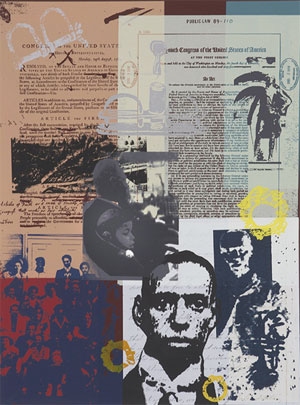Related events will celebrate the life of Lafayette’s first black graduate

"Legacy," a limited edition fine art print by master printmaker Curlee Raven Holton, celebrates and supports the creation of a campus sculpture honoring the College's first African American graduate, David Kearney McDonogh, Class of 1844.
Lafayette will dedicate “Transcendence,” a sculpture commemorating David Kearney McDonogh 1844, the College’s first black graduate, Saturday, Sept. 27, and will host related public events. McDonogh was a slave when he was sent by his owner to Lafayette in 1838.
Prior to the dedication ceremony, Richard Koplin ’64 and his daughter, actress Russell Koplin, will give a talk, “David K. McDonogh: A Transcendent Life,” 10 a.m. in the Gendebein Room of Skillman Library.
The dedication will follow at 11 a.m. by the sculpture on the north side of Skillman Library. Speakers will include Lafayette President Dan Weiss, Curlee Raven Holton, director of EPI and professor of art, and the artwork’s creator, internationally renowned sculptor Melvin Edwards.
College Archivist Diane Shaw will give a lecture, “‘By Example and Precept a Leader’: David K. McDonogh Class of 1844,” 12:15 p.m. Thursday, Sept. 25, in the Gendebein Room. A brown bag lunch will be provided at the event, which is sponsored by Friends of Skillman Library.
The College’s Experimental Printmaking Institute (EPI) engaged Edwards to create the sculpture, which will be installed 9 a.m. Thursday, Sept. 11, with a crane. The work stands about 16 feet tall and is constructed from 4 tons of steel. The rain date is Sept. 12.
Weiss spoke of McDonogh’s achievements in his inaugural remarks.
“McDonogh was sent to Lafayette by his master, a Louisiana rice planter, so he could receive training to join a group of missionaries to Liberia,” he said. “But McDonogh had other goals. He wanted to become a physician and, in the face of tremendous opposition, he prevailed, [attending classes] at the College of Physicians and Surgeons in New York and becoming, for the remainder of his career, a member of the staff of the New York Hospital and New York Eye and Ear Infirmary.”
Five years after McDonogh’s death in 1893, the McDonogh Memorial Hospital opened its doors as the first New York City hospital admitting both physicians and patients without discrimination by race.
“Think about the debate going on in the country when McDonogh was here! During this dialogue about the abolition of slavery, here he was at Lafayette, a slave, right in the middle of this advocacy to end slavery and change our social complexion,” says Holton, who produced a limited edition of 100 fine-art prints in celebration and support of the sculpture project.
“You see this man saying, ‘I’m an American! I want to be a doctor; I don’t want to go to Liberia, to a colony for freed slaves.’ McDonogh was more than his owner perceived him to be, and that humanity came through at Lafayette. We still see first-generation college students here, and Lafayette still represents that same doorway to opportunity. This is a portal through which students walk and emerge as members of society, and we are the caretakers of that transition.”
